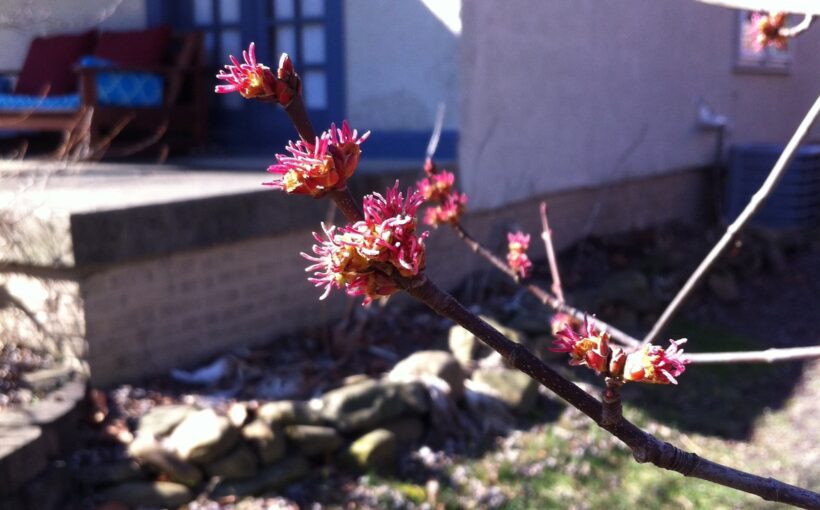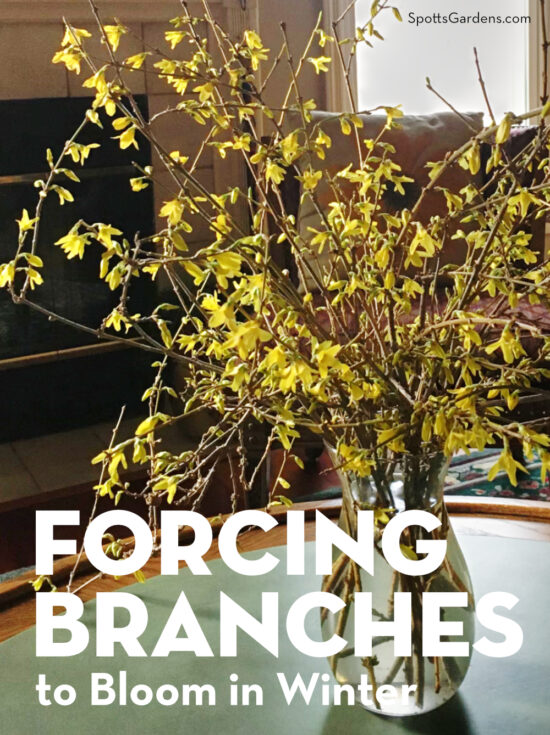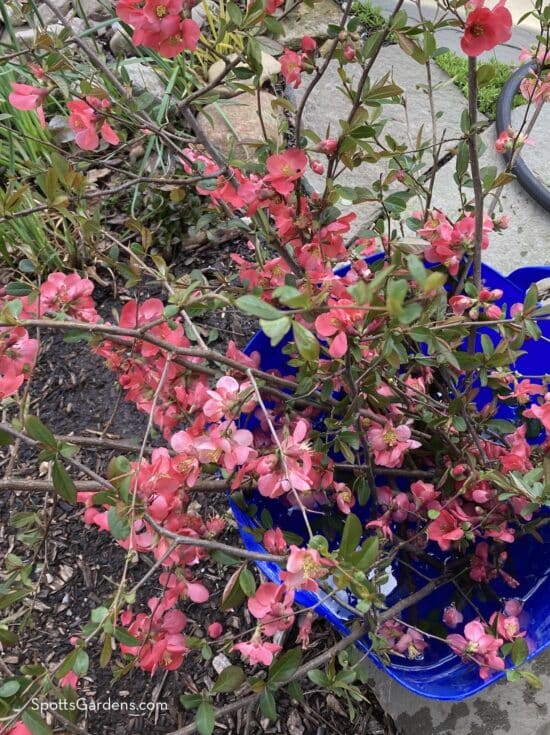As we continue to slog through winter, many gardeners start getting desperate for signs of spring. Fortunately, we can cheer up the winter doldrums by forcing branches.
“Forcing” means to manipulate plants into growing or blooming before their normal season. Trees and shrubs that flower in spring —like forsythia, maple, and witch hazel—formed their buds last fall. As a result, they’re primed to bloom as soon as they warm up. So by cutting stems and putting them in water, we can coax them into flowering several weeks before they would outside.
Plants for Forcing in Winter
Our favorite plants for winter forcing are trees and shrubs that normally bloom in early spring, from late February to about mid-April. Because these plants need a dormant period of about eight weeks of temperatures below 40°F before they’re ready to force, you can start cutting them as early as late January.
The closer they are to their normal bloom time when you cut them, the less time they’ll take to bloom in a vase.
Early Spring Plants to Force
These early spring-flowering shrubs have small blooms and take as little as two weeks to flower in a vase:
- Bridal wreath spirea (Spirea prunifolia)
- Flowering quince (Chaenomeles spp.; bottom photo)
- Forsythia (Forsythia spp.; title photo)
- Pussy willow (Salix discolor. Native to Indiana.)
- Red-twig dogwood (Cornus sericea. Native to Indiana.)
- Spicebush (Lindera benzoin. Native to Indiana.)
- Witch hazel (Hamamelis vernalis or the hybrids. Indiana’s native H. virginiana blooms in fall.)
Generally speaking, tree branches take a little longer to force than shrubs do. Choose slender, young branches, not thick limbs. Fruit trees require yearly pruning, so we prune apples and pears every year in February and bring some of the prunings in to force.
- Apples and crabapples (Malus spp.)
- Beech (Fagus spp. Fagus grandiflora is native to Indiana.)
- Birch (Betula spp. Several are native to Indiana. )
- Pears (Pyrus spp.)
- Red maple (Acer rubrum. Native to Indiana.)
- Serviceberry (Amelanchier spp. Several are native to Indiana.)
- Weeping willow (Salix babylonica)
Late Spring Plants to Force
While we particularly like the early spring bloomers, you can also force many plants that bloom from mid-April into May. Don’t start cutting these before March, or you’ll delay their bloom by several weeks. These larger blooms may take from two to five weeks to flower in a vase.
- Cherry, peach, plum, and other stone fruits (Prunus spp., ornamental or fruiting)
- Lilac (Syringa spp.)
- Magnolia (Magnolia spp. A few are native to Indiana.)
- Redbud (Cercis canadensis. Native to Indiana.)
- Rhododendron (Rhododendron spp.)
- Wisteria (Wisteria spp.)
If you start a new branch or two every two weeks, you can have indoor blooms from February to April! Check out this publication from Purdue Cooperative Extension Service for even more plants for forcing.
How to Force Branches
- Collect your branches for forcing on a mild day. Pick a day with temperatures in the high twenties or warmer.
- Choose young, slender branches or stems with lots of buds. Younger branches are more flexible and have buds that break dormancy easily.
- Cut your branches about 6″ to 18″ using a sharp pair of pruners. Prune small branches or twigs of trees at the branch collar: the point where a branch meets a limb. For shrubs, cut at the branch collar or cut a slender stem off at the ground.
- Bring the branches inside and submerge them in tepid water to condition them. Place them so that the entire branch is underwater, which loosens up the bud scales. If you cut during when the temperatures are above freezing, soak for a couple of hours; below freezing, soak four hours to overnight.
- After conditioning the branches, fill your vase or other container with lukewarm water. Add a floral food if you like, but it’s not necessary.
- Make a fresh, angled cut at the desired length and immediately put cut branches into the container.
That’s it! Change the water weekly, or if it starts to look cloudy. Forced branches do best in a relatively cool spot and out of bright sunlight.
Bonus! Making New Plants from Forced Stems
Some stems will develop roots in water, and you can use them to propagate new plants! This process is called rooting in water. It works best with stem cuttings from shrubs.
If you want to give it a try, we recommend forcing your stems in clear vases so you can watch roots develop.
- Follow the instructions for forcing.
- When the roots are about 1/4″ to 3/8″ long, take the forced stem out of the water .
- Cut the top off to make the stem 6″ to 8″ long. You now have a cutting.
- Immediately stick the cutting into a pot filled with moist potting soil, covering the baby roots.
- Then keep the soil moist until the cutting develops permanent roots.
- When the soil outside dries out enough for planting, transplant the cutting into a garden bed.
Enjoy Your Garden in Winter
Forcing branches is just one way to make the most of the garden in winter! Find others with Feeding Birds in the Winter Garden, Design for the Garden in Winter, and our other posts about the colder months outdoors.
We can help you create an outdoor space that offers you beauty in winter and all year round. Contact us today to discuss your four-season garden!


